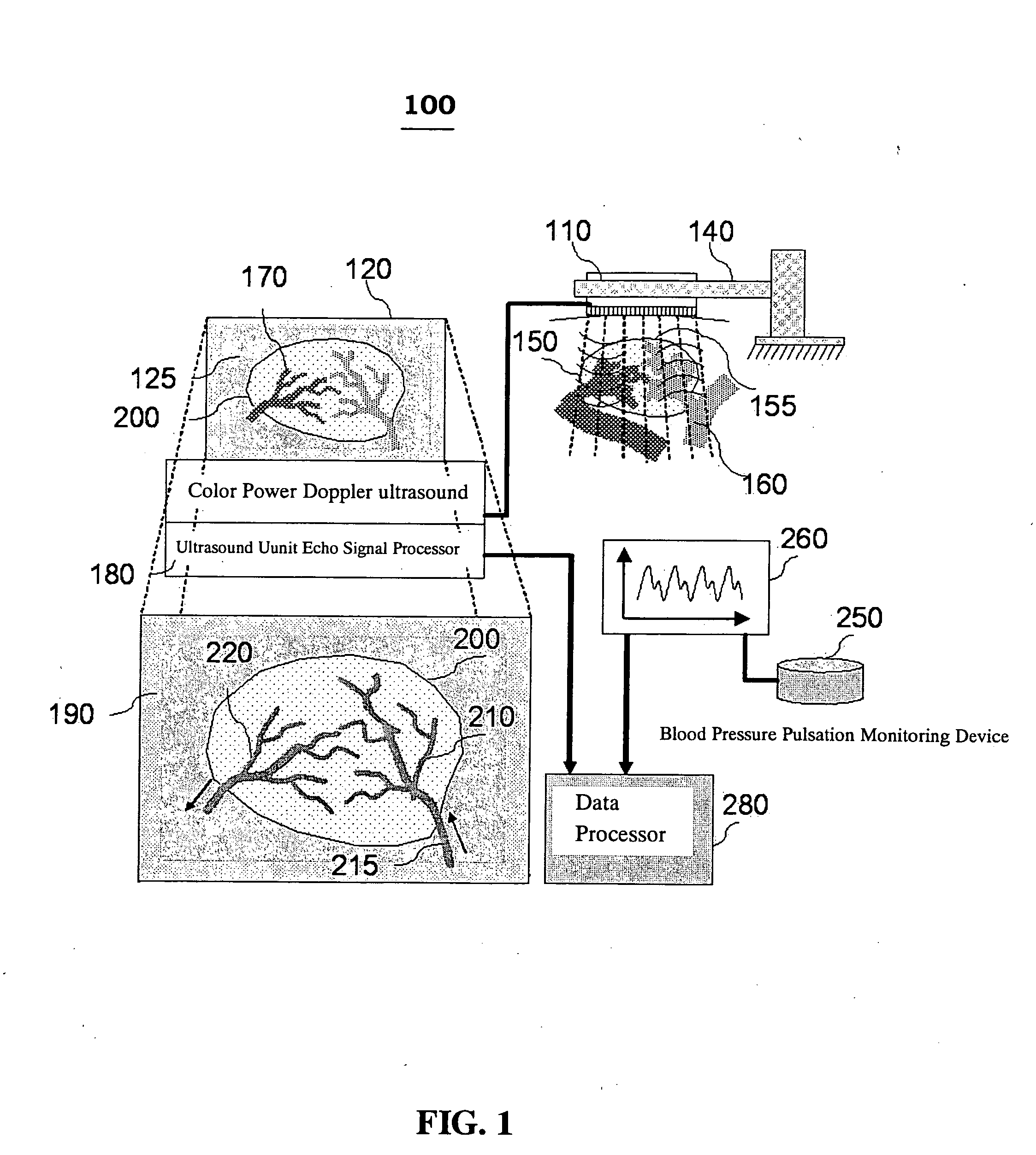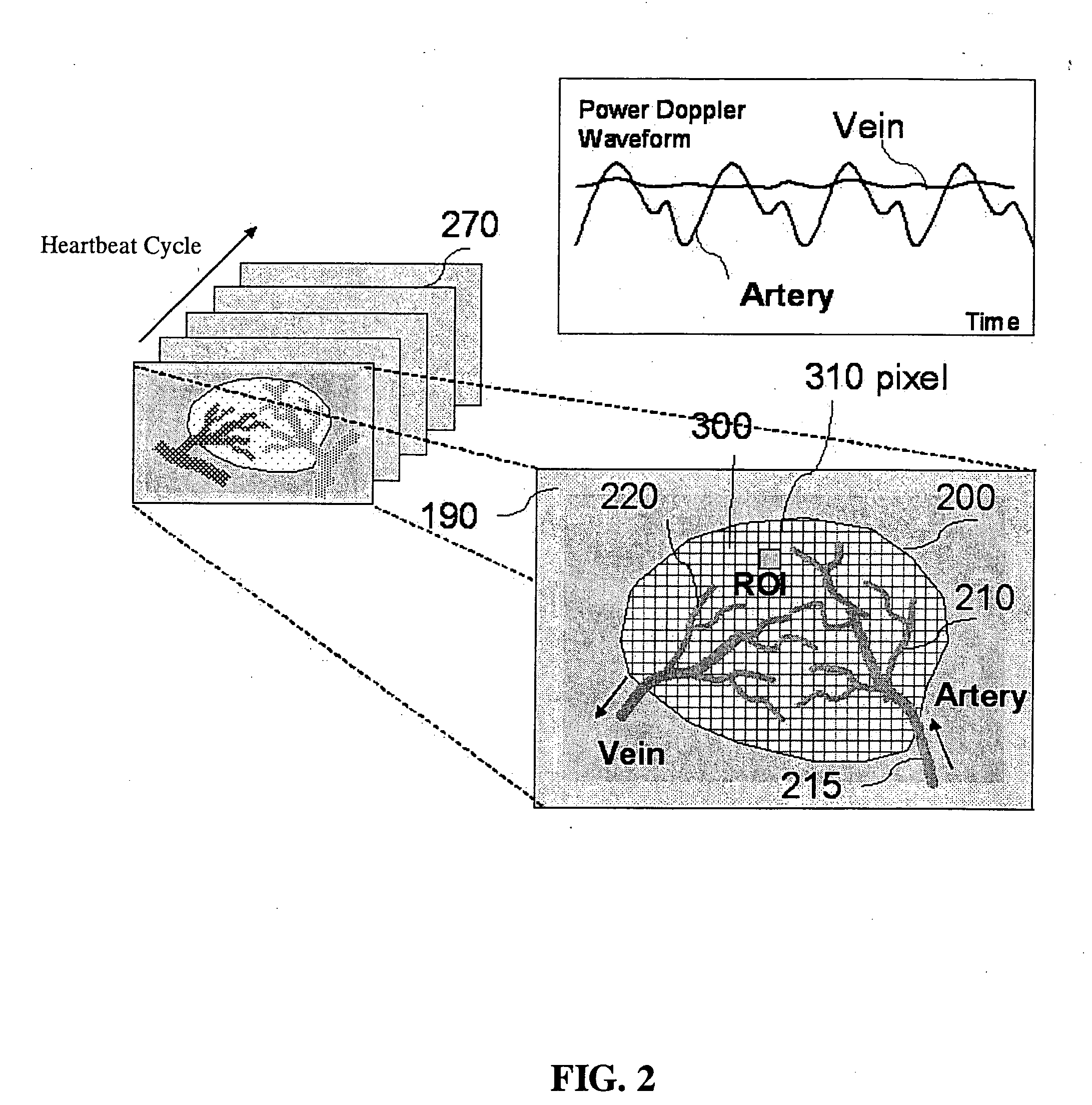Quantitative non-invasive method for detecting degree of malignancy in tumors and application thereof
a tumor and non-invasive technology, applied in the field of tumor hemodynamic parameters measurement and non-invasive measurement of tumors, can solve the problems of insufficient credibility, limited suitability of aforementioned detection, and many tumors, and achieves low resistance area, high resistance area, and high ratio of neovascular blood vessels
- Summary
- Abstract
- Description
- Claims
- Application Information
AI Technical Summary
Benefits of technology
Problems solved by technology
Method used
Image
Examples
example 1
[0061]FIG. 4 is an embodiment showing a diagnosed result using the method of the present invention in breast tumor detection. The sequential Power Doppler images of the breast tumor are shown in the bottom. Middle square represents the margin of region of interest (ROI) and cross-section of blood vessel which is contoured by Power Doppler ultrasound. Upper right corner shows the results expressing arterial vessel nests and venous vessel nests in the tumor ROI cross-section distinguished with arrows by Power Doppler variance waveform analysis (upper right corner). The present invention uses the flow ultrasounic imaging analysis to study the interaction between tumor and pressure of supplying artery, to distinguish the PDVI arterial and venous regions in tumor, and to effectively calculate the degree of angiogenesis in tumor. The neovascular density ratio in tumor detected with ultrasound can be helpful in disease subtype classification, in stratifying patients for either enhance the ...
example 2
[0062]FIG. 5 is an embodiment showing a diagnosed result using the method of the present invention in kidney blood perfusion detection. The vessel pixels contributed to tumor differential vascularity index (TDVI) area are also shown. (A) represents the ultrasonic Power Doppler image during maximal systolic stage; (B) shows the Power Doppler pixels in tumor region which are higher than energy threshold during maximal systolic stage and lower than energy threshold during maximal diastolic stage; and (C) shows the difference of TDVI area in red scale. The pixel location calculated with TDVI represents a group of blood vessels with low perfusion (the reflection signals of blood flow in the location will appear in systolic phase but disappear in diastolic phase). New blood vessels of tumor have small vessel diameters, low perfusion, thin and soft wall, which have made TDVI a good indicator for the area ratio of new blood vessels. TDVI of the invention can further be used to represent the...
example 3
[0063] Thyroid cancer can be divided into 4 groups according to the tissue malignancy, which are described respectively below: [0064] (1) Normal: tissues are sampled from another normal side of a thyroid tumor; [0065] (2) Nodule Goitar (NG): patients usually require no operative intervention but sonography detection; [0066] (3) Follicular Adenoma: lots of blood vessels proliferated in patients, the distinction between an adenoma versus a carcinoma is difficult, thyroidectomy is performed since carcinoma may be rendered from adenoma; [0067] (4) Papillary thyroid carcinoma (PTC): tumor of malignancy.
[0068] A total of 53 patients with tumor are scanned with Doppler ultrasound in the tumor regions non-invasively. The CDVI, FMBV, PDVI indices from common use and the TDVI index in the present invention are analyzed to determine the degree of abnormality and aggressiveness of the cancer cells
[0069] The tumor tissue sections are collected invasively and stained for endothelial cell CD34 a...
PUM
 Login to view more
Login to view more Abstract
Description
Claims
Application Information
 Login to view more
Login to view more - R&D Engineer
- R&D Manager
- IP Professional
- Industry Leading Data Capabilities
- Powerful AI technology
- Patent DNA Extraction
Browse by: Latest US Patents, China's latest patents, Technical Efficacy Thesaurus, Application Domain, Technology Topic.
© 2024 PatSnap. All rights reserved.Legal|Privacy policy|Modern Slavery Act Transparency Statement|Sitemap



